DEFINING PROBLEMS. SHAPING SOLUTIONS . - School of Social Service ...
DEFINING PROBLEMS. SHAPING SOLUTIONS . - School of Social Service ...
DEFINING PROBLEMS. SHAPING SOLUTIONS . - School of Social Service ...
You also want an ePaper? Increase the reach of your titles
YUMPU automatically turns print PDFs into web optimized ePapers that Google loves.
U N F U L F I L L E D F U T U R E S<br />
Dorow (2010, 74) draws our attention to something like moral<br />
maintenance in her study <strong>of</strong> Chinese adoption, in which international<br />
facilitators are shown protecting adoptive parents from “signs <strong>of</strong> a<br />
commodified child.” Dorow (2010, 72) contends, “A complex intersection<br />
<strong>of</strong> economic, political, cultural, and emotional labor by the formal<br />
facilitators <strong>of</strong> adoption buffers the production <strong>of</strong> kinship from the raced,<br />
gendered, and classed excesses <strong>of</strong> marketized relations that would make<br />
parent and child into consumer and consumed.” Moral maintenance is<br />
also involved in the rhetorical disavowal <strong>of</strong> adoption as being in any way<br />
economized. Goodwin (2010, 2) argues, “the free market in children, as<br />
a concept, is rejected based on what it symbolizes, including its argued<br />
resemblance to slavery or the auction block.” 6 Dorow (2010), however,<br />
has argued that despite this rejection <strong>of</strong> financial motivations in the<br />
adoption process, the free market in children does exist and continues<br />
to influence how adoptions unfold. Alluding to the market’s negative<br />
impacts on adoption, Dorow (2010, 81) closes, “While markets play a key<br />
and even welcomed role in the production <strong>of</strong> transnational, transracial<br />
adoptive kinship, they only sometimes absorb or deflect the dangers <strong>of</strong><br />
commodification.” One <strong>of</strong> these dangers is, inevitably, the fall-through.<br />
When I asked Stella to differentiate adoption from child-buying, she argued<br />
that several central aspects <strong>of</strong> child trafficking were absent from legitimate<br />
adoption: spontaneous or unexplained fees, working with non-certified<br />
individuals, and the absence <strong>of</strong> paperwork. In Stella’s view, the line between<br />
adoption and illicit trafficking is marked by a lack <strong>of</strong> regulation, a defining<br />
trait <strong>of</strong> baby markets (Goodwin 2010).<br />
In both lay and scholarly discourse, adoptees have been conceptualized<br />
as both market commodity (Rothman 2004; Roberts 1997; Dorow 2010;<br />
Ertman 2010; Goodwin 2010) and gift (Buckley 2001; Firth 2006; Gift <strong>of</strong><br />
Adoption Fund 2009; A Precious Gift 2010; Gift <strong>of</strong> Life Adoptions 2010).<br />
However, in an analysis <strong>of</strong> domestic adoption fall-throughs and possible<br />
birth mother “scams,” it is difficult to conceptualize the unborn adoptee as<br />
anything more than an idea, potentiality, or future, which as such may be<br />
more powerful than a living, breathing, material child. This future is one in<br />
which large investments are made, not unlike what occurs in the realm <strong>of</strong><br />
futures trading. The idea <strong>of</strong> baby as future or potentiality requires a great<br />
deal <strong>of</strong> emotional, temporal, and financial investment. These investments<br />
put the adoptive family at a great deal <strong>of</strong> perceived risk; the risk <strong>of</strong> losing<br />
not just hundreds or thousands <strong>of</strong> dollars and months or years <strong>of</strong> their<br />
time, 7 but the risk <strong>of</strong> losing what they have already come to think <strong>of</strong> as their<br />
son or daughter, an as yet unborn child.<br />
16
















